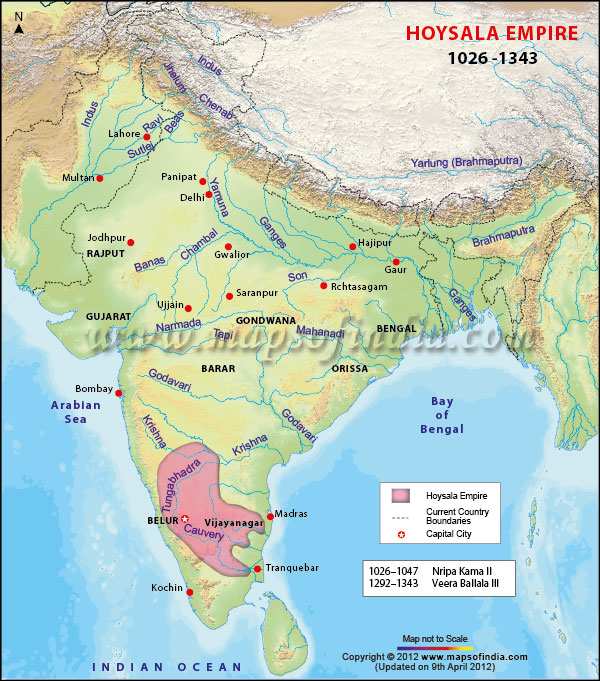One of the famous dynasties in the Southern India, Hoysala dynasty is also one of the premiere ruling families of Karnataka. Though vast regions of the northern part of Karnataka were also ruled by this dynasty but it majorly ruled and was based in the South of
Karnataka . Also occasional forays into the areas, which were non-Kannada, were also made by the Hoysala dynasty.
As per historians and texts, the Hoysalas are generally linked with the Yadava Vamsha of the North. 'Hoysalas were indigenous to Karnataka' and this is universally known. This dynasty had its origin in the hilly state of Malengadu. The name of the specific place of their origin is 'Angadi' (sosevuru), as per the historians. 'Angadi' is located in the Mudigere Talluk of the district of Cikkamagaluru. It is believed that there were intimate relations and connections of the Hoysalas with the Gangas. The Gangas were the ancient rulers of the same region in the early times. It was in the very beginning of the eleventh century that the Hoysala dynasty came into being it flourished till the mid-fourteenth century.
It should be known that the kingdom was divided into two parts by King Someshvara between his two children, namely Narasimha III and Ramanatha. Narasimha ruled from Dvarasamdra and Ramanatha ruled from Kannanuru. Ramanatha's later branch came to be known as 'Hoysalas of
Tamil Nadu' but it did not have much longevity.
Out of some most renowned monarchs of Karnataka, Vishnuvardhana is one. The victories and battles of Vishnuvardhana are well documented. Some of his main victories were over the Cholas of Talakadu, the Cholas of Kanchi and also freedom from the Chalukyas.
Another very important king is Ballala II who ruled for about fifty years. Some of his commendable achievements were his victories over the Kongalvas and the Cengalvas and conquest over the fort of Uccangi Durga in 1177 A.D.
Though no major reforms and changes were brought in the administrative systems and socio-economical practices by the Hoysala as set by the Gangas and Chalukyas, the Hoysalas were seen giving noticeable importance to the women in administration and also adopting catholic attitude towards different religions. In regions like Somanathapura, Belluru, Savajnapur and Agrahara education centers were developed since education was started to be taken in high esteem. Belluru and Somnathapura had become household names in Karnataka.
The Hoysala dynasty not only contributed to the architecture and sculpture of the South India but also in art and literature in a great manner. Great poets such as Janna, Kereya Padmarasa, Achanna and Nemichandra and learned people and scholars like Mallikarjuna, Keshiraja and Rajaditya were proteges or contemporaries of Hoysala kings. The Hoysalas encouraged music and dance very much which can be well attested by their sculpture.
During the reign of the Hoysala rulers, installation of many hero stones and inscriptions took place. There were so many stone inscriptions installed that it even outnumbered the copper inscriptions. These inscriptions generally conveyed and celebrated the sacrifices of the people who sacrificed their lives in the service of their kings and for the dynasty. Out of all these, the well known inscriptions are at Halebidu (Kuvara Lakshmana Shasana), Agrahara and Bacahalli.
Hoysala dynasty is very significant for the Kannada history since it maintains the reign of indigenous Kannada kings and plays an important role as a kingdom chronologically sandwiched between the Chalukyas and the Vijayanagara Empire.
Last Updated on: November 13, 2025

